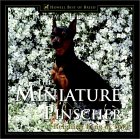
Miniature Pinscher: Reigning King of Toys
Miniature Pinschers look like small Dobermanns, and have some characteristics in common, such as feeling the cold, and being very trainable, though also wilful. They are a good breed for an active retired person who has experience of dogs, since they are very rewarding as obedience and agility dogs, and like company during the day, yet they are less likely to pull you off your feet than larger breeds.
It's best to start training Miniature Pinschers when they are young, since they can be headstrong, and have a tendency to chase small prey, so a lot of effort is needed with ensuring they have a solid recall. It's a good idea to learn a repertoire of indoor games, since they don't like going out in cold weather. They can be fretful and barky indoors if they are bored. You also need to ensure that they do wee when they go out, or they may seek to go home without a wee, later leaving you with a puddle indoors.
Gardens should be well-fenced, since Min Pins are agile dogs, and can surprise you with their ability to escape. They should also be well-socialised, since they can be suspicious of strange humans and dogs, though well-socialized individuals are usually good with children and other dogs. Children should be taught to respect them, and not try to pick them up, or otherwise handle them roughly.
Grooming is simple, since this is a short-haired breed, and they can be just tidied with a damp cloth, to remove loose hairs. Common health problems include Legge Perthes, eye trouble, and luxating patella.
Jacklyn Hungerland's book is especially useful for tips on training, and activities which owners can share with their Min Pins. There is also advice on general care, as well as an account of the history of the breed.



